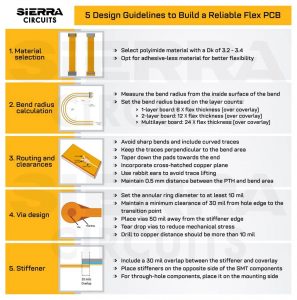Flex PCB Manufacturing Considerations
PCB Manufacturing Considerations
A flex PCB is a circuit board that features conductive tracks on a flexible base material like polyimide. The flexibility of the base allows flex circuits to withstand vibration, dissipate heat and fold into various shapes. This makes flex circuits useful for compact and innovative electronics. In order to produce a high-quality flex circuit, there are several important considerations that manufacturers should take into account.
One of the main factors is choosing the right materials for the flex circuit. Since flex circuits have to endure high levels of stress, the material used must be able to withstand these stresses. The thickness of the material is also important. The thinner the material, the more flexible the circuit board will be. The other major factor is the design of the conductive pattern. A flex PCB manufacturer should ensure that the conductive pattern is evenly distributed across the whole area. This will minimize the risk of shorting out or conducting through areas of the flex circuit.

Lastly, the manufacturer must consider the thickness of the conductor. Since flex circuits must be flexible, the conductive layer must be thin enough to bend without breaking. Thinner layers will also reduce the risk of electrical interference.
Flex PCB Manufacturing Considerations
Additionally, the flex circuits must be able to handle high temperatures. This is why the conductor layer is coated with a solder mask. This coating provides insulation and anti-oxidation protection. The solder mask is also necessary for ensuring that components are properly aligned and fixed in place.
The manufacturer must also determine the best way to protect the flex circuit from damage during manufacturing and assembly. This includes choosing the right surface finish. For example, a good surface finish will prevent static electricity and provide better adhesion to the underlying copper. In addition, a good surface finish can help resist corrosion.
For assembly, the flex circuit is attached to a rigid board. This is done using a process known as “blanking.” The blanking process involves a hydraulic punch and die set, which requires relatively high tooling costs. However, a flex circuit manufacturer can save time and money by using a photoimageable solder mask. This method is similar to the one used on rigid boards, and it is very quick and efficient.
A flex PCB manufacturer should also consider the use of stiffeners for certain parts of the flex circuit. Stiffeners are made of a rigid material such as FR-4 and are added to specific sections of the flex circuit to increase its rigidity. They are especially needed in the areas of the flex circuit that have to bend at a tight radius.
As a general rule of thumb, it is better to choose a flex PCB with multiple holes for ICs and other components. This will reduce the likelihood of shorting and improve reliability. Additionally, a flex PCB should be designed with rounded edges to increase its tear resistance. In addition, a flex PCB should not have solid copper areas because this will decrease the flexibility of the circuit. Using hatched or cross-hatched copper is a better option.